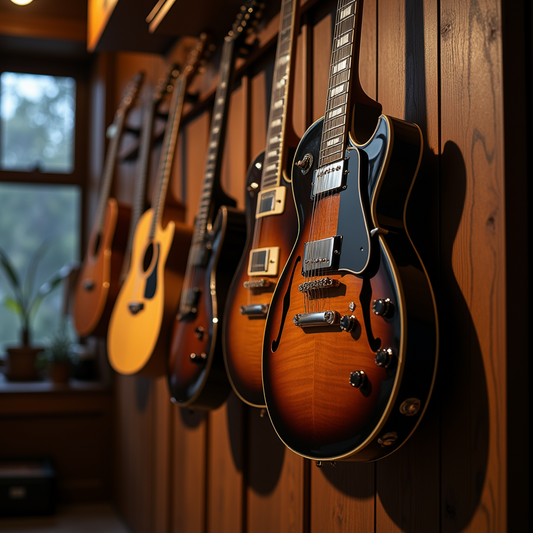The Ultimate Guide for New Guitar Players
Share
Introduction
Starting your guitar journey can be an exciting yet overwhelming experience. Whether you're eager to learn your favorite song or understand the basics of music theory, this guide will help you lay the foundation for your success. As a beginner, knowing what to focus on and how to approach learning can make all the difference in your progress. In this post, we’ll share the best practices, tips, and advice to help you get started.
1. Choosing Your First Guitar
When you’re starting out, the most important decision is picking the right guitar. Beginners often face the dilemma of whether to choose an acoustic, electric, or classical guitar. Here’s a quick breakdown:
-
Acoustic Guitar: Great for beginners. No need for an amplifier, and it's excellent for learning basic chords and finger techniques.
-
Electric Guitar: Ideal for players interested in rock, metal, or modern styles. It requires an amp, but it’s easier to press the strings due to lighter tension.
-
Classical Guitar: Perfect for fingerstyle players and classical music enthusiasts. It has nylon strings, making it softer on your fingers but requires more attention to technique.
Key Tip: If you're unsure, go for an acoustic guitar—it’s versatile, easy to maintain, and ideal for building foundational skills.
2. Understanding Basic Guitar Anatomy
Before you begin playing, it's essential to know the parts of your guitar. Familiarizing yourself with terms like the body, neck, fretboard, and headstock will make it easier to follow lessons. Here’s a quick overview:
-
Body: The large part of the guitar that amplifies sound (especially important for acoustic guitars).
-
Neck and Fretboard: Where your fingers will play most of the notes. Understanding fret positions will make playing chords easier.
-
Headstock: Contains the tuners (the pegs you turn to tune the strings).
Key Tip: Practice adjusting your guitar’s tuning regularly. A well-tuned guitar sounds far better and helps you get used to tuning mechanisms.
3. Learning Basic Guitar Chords
One of the first things you’ll learn on your guitar journey is how to play basic chords. The most common beginner chords are:
-
G Major
-
C Major
-
D Major
-
A Minor
These chords form the foundation for thousands of popular songs! Start by learning these basic chords, making sure to practice finger placement and transitioning smoothly between them.
Key Tip: Use a metronome to help you maintain a steady rhythm as you practice these chords. Start slow and gradually increase your speed.
4. Strumming and Picking Techniques
Once you’ve mastered basic chords, it’s time to focus on rhythm. Strumming and picking are essential skills every guitarist must learn. Start with simple downstrokes (strumming down with your pick) and practice with open chords. Once you feel comfortable, you can experiment with upstrokes and more complex patterns.
Key Tip: Practice with a clean sound—strumming too hard or too softly can affect your rhythm. Find a comfortable balance.
5. Learning Simple Songs
There’s no better way to solidify what you’ve learned than by playing songs you love. Begin with easy songs that use basic chords. Some beginner-friendly options include:
-
"Knockin' on Heaven's Door" by Bob Dylan (G, D, A minor)
-
"Twinkle Twinkle Little Star" (C, G, F)
-
"Horse with No Name" by America (Em, D6add9/F#)
These songs are simple, repetitive, and will help you build confidence as you improve your playing.
Key Tip: Focus on learning one song at a time to avoid feeling overwhelmed. Mastering a song will give you the motivation to keep practicing.
6. Using Online Resources and Guitar Apps
The internet is full of resources for beginner guitarists. From YouTube tutorials to apps like GuitarTuna (for tuning) and Yousician (for guided lessons), there are countless tools to speed up your learning process. Here are some to explore:
-
JustinGuitar: A comprehensive website with free lessons for all skill levels.
-
GuitarTricks: Offers step-by-step video lessons with a subscription model.
-
Fender Play: Fender's app for learning guitar, offering beginner-friendly courses.
Key Tip: Use a combination of online lessons and apps to stay engaged. Practice regularly, and don’t be afraid to rewind lessons if something is unclear.
7. Developing Finger Strength and Dexterity
Building finger strength and dexterity is essential to playing guitar efficiently. Daily practice will gradually improve your finger coordination. Here are some tips to speed up the process:
-
Practice finger exercises: Simple chromatic scales and finger stretches will help you build strength and flexibility.
-
Use a fingerboard chart: It helps you visualize where each note is on the fretboard, speeding up muscle memory development.
Key Tip: Don't push too hard in the beginning. If your fingers feel sore, take breaks and allow your hands to rest.
8. Understanding Guitar Tuning and Maintenance
Your guitar needs regular care to ensure longevity and good sound quality. Here are some essential maintenance tips:
-
Tune regularly: Keep your guitar in tune before every practice session.
-
Change strings: Strings wear out and lose their tone. Depending on how often you play, change them every 3–6 months.
-
Clean the fretboard: Keep it free of dust and grime to maintain smooth playability.
Key Tip: Store your guitar properly in a case to avoid damage to the neck and body.
Conclusion
Starting your guitar journey is exciting, and with the right tools, mindset, and practice, you’ll see incredible progress. Remember, consistency is key. Enjoy every step of the learning process, from strumming your first chord to playing your favorite songs.
Stay dedicated, keep playing, and most importantly, have fun!



